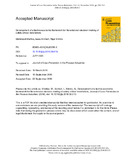JavaScript is disabled for your browser. Some features of this site may not work without it.
| dc.contributor.author | Shafiee, Mahmood | |
| dc.contributor.author | Animah, Isaac | |
| dc.contributor.author | Simms, Nigel J. | |
| dc.date.accessioned | 2016-11-24T11:14:43Z | |
| dc.date.available | 2016-11-24T11:14:43Z | |
| dc.date.issued | 2016-09-22 | |
| dc.identifier.citation | Shafiee M, Animah I, Simms N, Development of a techno-economic framework for life extension decision making of safety critical installations, Journal of Loss Prevention in the Process Industries, Volume 44, November 2016, pp. 299-310. | en_UK |
| dc.identifier.issn | 0950-4230 | |
| dc.identifier.uri | http://dx.doi.org/10.1016/j.jlp.2016.09.013 | |
| dc.identifier.uri | http://dspace.lib.cranfield.ac.uk/handle/1826/11022 | |
| dc.description.abstract | One of the major decisions in management of the industrial assets is to ensure the feasibility of life extension process for safety critical components when they reach end-of-life. Most of the existing life extension decision-making models are restricted solely to either “technical” or “economic” feasibility analyses that may lead to inaccurate results or incorrect conclusions. In this paper, a comprehensive life extension feasibility assessment framework by taking into account both the technical and economic considerations is developed. The proposed techno-economic model for life extension of safety critical elements consists of three phases: preparation, assessment, and implementation. The technical assessment part of the framework incorporates all aspects of data collection and review, screening and prioritization of safety critical elements, condition assessment, estimation of remaining useful life, and risk analysis, while the economic assessment part deals with cost-benefit analysis. The decision to qualify a safety critical element for continuous operation beyond its service life is made based on a “life extension measure (LEM)” which is calculated by combining two indexes of “equipment health condition” and “economic added-value” obtained respectively from the technical and economic assessments. The model is applied to support the life extension decision-making procedure for water deluge systems in offshore oil installations. The results of the study show that the model is highly capable of assisting asset owners to evaluate the technical and economic benefits of extending the service life of components. | en_UK |
| dc.language.iso | en | en_UK |
| dc.publisher | Elsevier | en_UK |
| dc.rights | Attribution-NonCommercial-NoDerivatives 4.0 International | |
| dc.rights.uri | http://creativecommons.org/licenses/by-nc-nd/4.0/ | |
| dc.subject | Safety Critical Element (SCE) | en_UK |
| dc.subject | Life Extension (LE) | en_UK |
| dc.subject | Reliability | en_UK |
| dc.subject | Techno-Economic Analysis | en_UK |
| dc.subject | Maintenance | en_UK |
| dc.subject | Offshore Oil and Gas | en_UK |
| dc.title | Development of a techno-economic framework for life extension decision making of safety critical installations | en_UK |
| dc.type | Article | en_UK |
Files in this item
This item appears in the following Collection(s)
-
Staff publications (SWEE) [2825]

